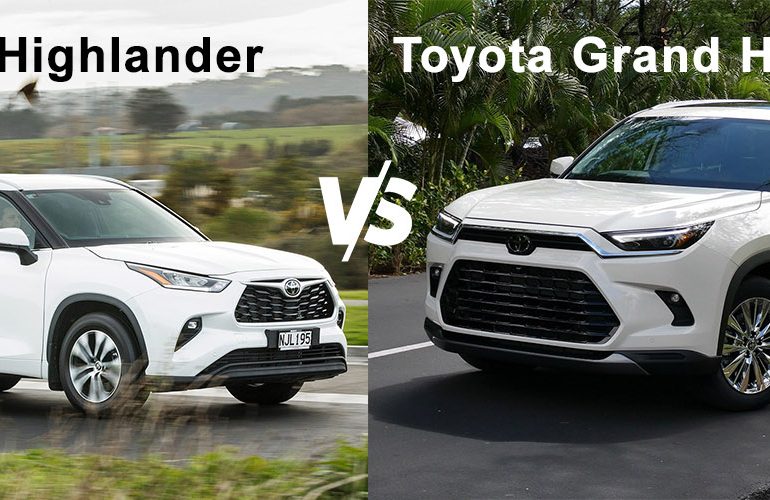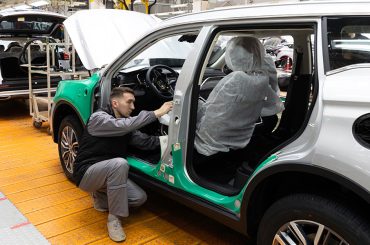Toyota’s SUV lineup includes two compelling three-row options that often leave buyers wondering which model suits their needs better. The Highlander has been a family favorite for years, while the Grand Highlander represents Toyota’s newest entry into the full-size SUV market. Understanding the key distinctions between these vehicles helps shoppers make an informed decision.
Size and Dimensions Set Them Apart
The most obvious difference lies in their physical footprint. The Grand Highlander stretches 194.9 inches in length compared to the standard Highlander’s 194.9 inches, making it notably longer. However, the Grand Highlander’s width increases to 78.3 inches versus 76.0 inches for the regular model.
Height differences become apparent when parking in garages or under low clearances. The Grand Highlander stands 70.1 inches tall, while the Highlander measures 68.1 inches. These two inches might seem minimal, but they can affect garage clearance and create a more imposing road presence.
| Dimension | Toyota Highlander | Grand Highlander | Difference |
| Length | 194.9 inches | 196.4 inches | +1.5 inches |
| Width | 76.0 inches | 78.3 inches | +2.3 inches |
| Height | 68.1 inches | 70.1 inches | +2.0 inches |
| Wheelbase | 112.2 inches | 115.0 inches | +2.8 inches |
Wheelbase measurements reveal another significant gap. The Grand Highlander’s extended wheelbase translates to improved interior space and ride quality. The longer wheelbase also enhances stability during highway driving and provides better weight distribution.
Interior Space and Seating Configuration
Passenger Capacity Advantages
Both vehicles offer three rows of seating, but the Grand Highlander maximizes passenger comfort through clever design. The Grand Highlander accommodates up to eight passengers when equipped with second-row bench seating, matching the standard Highlander’s capacity. However, captain’s chairs become available on higher trim levels, reducing capacity to seven while significantly improving second-row comfort.
Third-row access proves easier in the Grand Highlander thanks to wider door openings and improved entry angles. Adults can actually fit comfortably in the third row, unlike the standard Highlander where the back seats work best for children or shorter passengers.
Cargo Space Differences
Storage capacity represents a major selling point for the Grand Highlander. The following table highlights the cargo capacity advantages:
| Cargo Configuration | Toyota Highlander | Grand Highlander | Difference |
| Behind 3rd Row | 16.0 cu ft | 20.9 cu ft | +4.9 cu ft |
| 3rd Row Folded | 44.2 cu ft | 46.9 cu ft | +2.7 cu ft |
| Maximum Capacity | 84.3 cu ft | 97.5 cu ft | +13.2 cu ft |
Families with significant hauling needs will appreciate this extra storage volume, especially the substantial 13.2 cubic feet increase when both rear rows fold flat.
Engine Performance and Powertrain Options
Standard Engine Specifications
The standard Highlander relies on a 2.4-liter turbocharged four-cylinder engine producing 265 horsepower and 309 lb-ft of torque. The Grand Highlander steps up with a more powerful 2.4-liter turbocharged four-cylinder that delivers 265 horsepower but increases torque output significantly.
Both engines pair with an eight-speed automatic transmission, but the Grand Highlander’s additional weight requires more power for similar performance. The larger SUV compensates with revised gearing and enhanced cooling systems to maintain reliability under heavier loads.
Hybrid Powertrain Availability
Hybrid variants offer different approaches to fuel efficiency. The Highlander Hybrid combines a 2.5-liter four-cylinder engine with electric motors for a total system output of 243 horsepower. The Grand Highlander Hybrid uses a similar setup but optimizes the system for the larger vehicle’s needs.
| Fuel Economy (EPA Est.) | Highlander | Highlander Hybrid | Grand Highlander | Grand Highlander Hybrid |
| City MPG | 24 | 36 | 22 | 35 |
| Highway MPG | 32 | 35 | 28 | 34 |
| Combined MPG | 27 | 36 | 24 | 35 |
The fuel economy numbers show the trade-off between size and efficiency, with hybrid versions providing significant improvements for both models.
Technology and Feature Availability
Infotainment System Differences
Standard equipment varies between the two models. The Highlander includes an 8-inch touchscreen display as standard equipment, while the Grand Highlander upgrades to a 12.3-inch touchscreen across most trim levels. The larger screen improves visibility and makes menu navigation easier for all passengers.
Both vehicles support wireless Apple CarPlay and Android Auto connectivity, but the Grand Highlander adds wireless device charging as standard equipment on more trim levels. USB port placement also differs, with the Grand Highlander offering more charging options for third-row passengers.
Safety Technology Integration
Toyota Safety Sense 2.0 comes standard on both vehicles, providing features like pre-collision warning, lane departure alert, and adaptive cruise control. However, the Grand Highlander includes additional safety technologies such as rear cross-traffic alert and blind spot monitoring as standard equipment on more trim levels.
The Grand Highlander’s larger size allows for improved sensor placement, potentially enhancing the effectiveness of safety systems. The broader stance and longer wheelbase also contribute to better stability during emergency maneuvers.
Pricing Structure and Value Proposition
Starting Price Points
The pricing structure reveals the value proposition of each model:
| Trim Level | Toyota Highlander | Grand Highlander | Price Difference |
| L (Base) | $36,420 | $42,420 | +$6,000 |
| LE | $39,220 | $45,220 | +$6,000 |
| XLE | $41,770 | $47,770 | +$6,000 |
| Limited | $46,220 | $52,220 | +$6,000 |
| Platinum | $49,020 | $55,020 | +$6,000 |
The consistent $6,000 price gap across trim levels reflects the additional size, features, and capabilities of the larger SUV while maintaining proportional value throughout the lineup.
Feature Content Value
The Grand Highlander includes more standard equipment at each trim level, helping justify the higher price point. Standard features like the larger touchscreen, additional USB ports, and enhanced interior materials add value for buyers who prioritize luxury and convenience.
Long-term ownership costs may favor the Grand Highlander for families who need maximum space and capability. The improved fuel economy of hybrid versions and higher resale values help offset the initial price premium over time.
Conclusion
The choice between Toyota Highlander and Grand Highlander ultimately depends on specific family needs and budget considerations. The standard Highlander offers proven reliability, better fuel economy, and lower pricing for families seeking a capable three-row SUV without maximum size requirements.
The Grand Highlander appeals to buyers who need genuine full-size SUV capability, improved third-row comfort, and maximum cargo capacity. While the higher price creates a barrier for some shoppers, the additional space and enhanced features provide excellent value for families who can utilize the extra room.
Both vehicles maintain Toyota’s reputation for reliability and safety while serving different segments of the SUV market. Consider passenger requirements, cargo needs, and budget constraints when choosing between these capable family haulers.





